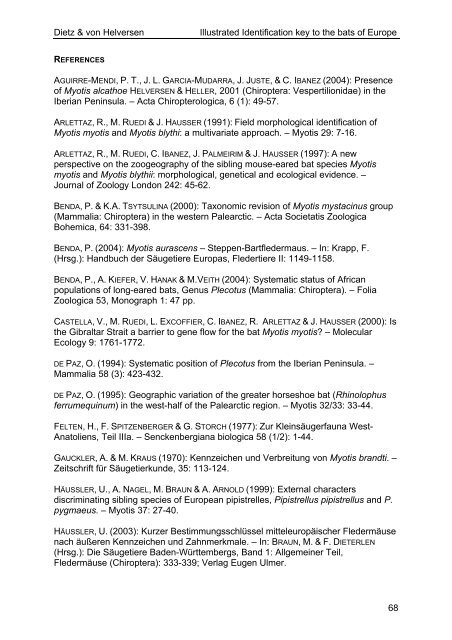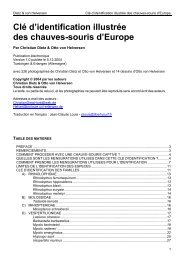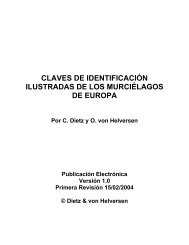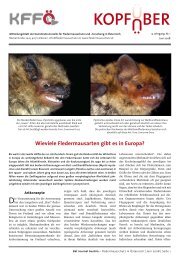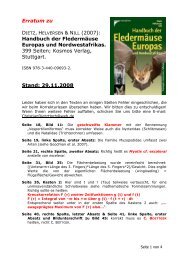Dietz & von Helversen Illustrated Identification key to the bats of ...
Dietz & von Helversen Illustrated Identification key to the bats of ...
Dietz & von Helversen Illustrated Identification key to the bats of ...
You also want an ePaper? Increase the reach of your titles
YUMPU automatically turns print PDFs into web optimized ePapers that Google loves.
<strong>Dietz</strong> & <strong>von</strong> <strong>Helversen</strong><strong>Illustrated</strong> <strong>Identification</strong> <strong>key</strong> <strong>to</strong> <strong>the</strong> <strong>bats</strong> <strong>of</strong> EuropeREFERENCESAGUIRRE-MENDI, P. T., J. L. GARCIA-MUDARRA, J. JUSTE, & C. IBANEZ (2004): Presence<strong>of</strong> Myotis alcathoe HELVERSEN & HELLER, 2001 (Chiroptera: Vespertilionidae) in <strong>the</strong>Iberian Peninsula. – Acta Chiropterologica, 6 (1): 49-57.ARLETTAZ, R., M. RUEDI & J. HAUSSER (1991): Field morphological identification <strong>of</strong>Myotis myotis and Myotis blythi: a multivariate approach. – Myotis 29: 7-16.ARLETTAZ, R., M. RUEDI, C. IBANEZ, J. PALMEIRIM & J. HAUSSER (1997): A newperspective on <strong>the</strong> zoogeography <strong>of</strong> <strong>the</strong> sibling mouse-eared bat species Myotismyotis and Myotis blythii: morphological, genetical and ecological evidence. –Journal <strong>of</strong> Zoology London 242: 45-62.BENDA, P. & K.A. TSYTSULINA (2000): Taxonomic revision <strong>of</strong> Myotis mystacinus group(Mammalia: Chiroptera) in <strong>the</strong> western Palearctic. – Acta Societatis ZoologicaBohemica, 64: 331-398.BENDA, P. (2004): Myotis aurascens – Steppen-Bartfledermaus. – In: Krapp, F.(Hrsg.): Handbuch der Säugetiere Europas, Fledertiere II: 1149-1158.BENDA, P., A. KIEFER, V. HANAK & M.VEITH (2004): Systematic status <strong>of</strong> Africanpopulations <strong>of</strong> long-eared <strong>bats</strong>, Genus Plecotus (Mammalia: Chiroptera). – FoliaZoologica 53, Monograph 1: 47 pp.CASTELLA, V., M. RUEDI, L. EXCOFFIER, C. IBANEZ, R. ARLETTAZ & J. HAUSSER (2000): Is<strong>the</strong> Gibraltar Strait a barrier <strong>to</strong> gene flow for <strong>the</strong> bat Myotis myotis? – MolecularEcology 9: 1761-1772.DE PAZ, O. (1994): Systematic position <strong>of</strong> Plecotus from <strong>the</strong> Iberian Peninsula. –Mammalia 58 (3): 423-432.DE PAZ, O. (1995): Geographic variation <strong>of</strong> <strong>the</strong> greater horseshoe bat (Rhinolophusferrumequinum) in <strong>the</strong> west-half <strong>of</strong> <strong>the</strong> Palearctic region. – Myotis 32/33: 33-44.FELTEN, H., F. SPITZENBERGER & G. STORCH (1977): Zur Kleinsäugerfauna West-Ana<strong>to</strong>liens, Teil IIIa. – Senckenbergiana biologica 58 (1/2): 1-44.GAUCKLER, A. & M. KRAUS (1970): Kennzeichen und Verbreitung <strong>von</strong> Myotis brandti. –Zeitschrift für Säugetierkunde, 35: 113-124.HÄUSSLER, U., A. NAGEL, M. BRAUN & A. ARNOLD (1999): External charactersdiscriminating sibling species <strong>of</strong> European pipistrelles, Pipistrellus pipistrellus and P.pygmaeus. – Myotis 37: 27-40.HÄUSSLER, U. (2003): Kurzer Bestimmungsschlüssel mitteleuropäischer Fledermäusenach äußeren Kennzeichen und Zahnmerkmale. – In: BRAUN, M. & F. DIETERLEN(Hrsg.): Die Säugetiere Baden-Württembergs, Band 1: Allgemeiner Teil,Fledermäuse (Chiroptera): 333-339; Verlag Eugen Ulmer.68


